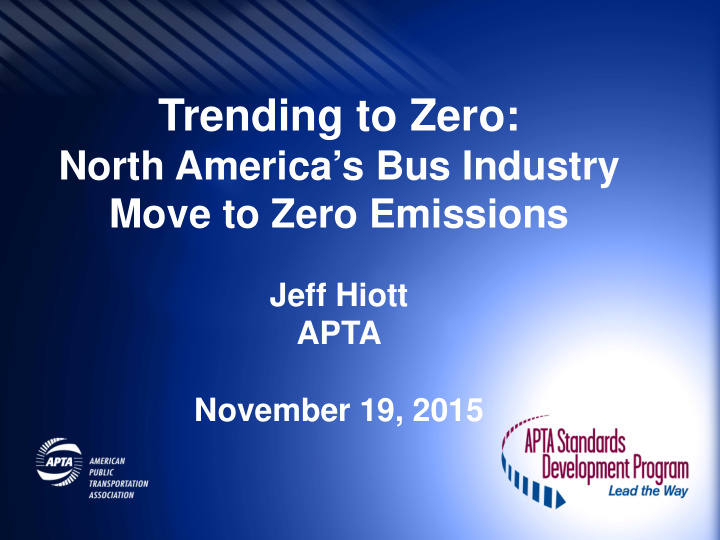



Trending to Zero: North America’s Bus Industry Move to Zero Emissions Jeff Hiott APTA November 19, 2015
Zero Emission Buses •Transit Bus Technologies • Zero Emission Buses: •Incumbent Technologies: • Fuel Cell Electric • Diesel Buses • CNG Reformation • CNG Buses • Renewable • Diesel-Hybrid Buses Hydrogen Sources • Battery Electric • Opportunity Charging • Inductive • Conductive • Overnight Charging
Getting there… Zero emission buses (ZEBs) are on the cusp of commercialization. Market development for this clean technology can be accelerated through the adoption of fuel cell and battery electric bus procurement practices that strategically balance risk between transit properties, industry and the public sector.
Getting there… • Dialog among stakeholders involved in the procurement process • Identify “solutions” to address problem(s) • Identify effective & efficient process for making change
Getting there… Zero Emission Bus Risk Management in Procurement recommended solutions… – Building Operator Knowledge Base (Performance Specifications, etc.) – Spare Ratio Exemption – Temporary Operational Obligation Waiver – Subcomponent Lease Options
State of Technology Courtesy: Center for Transportation and the Environment
Trends
Projected Growth as a Percent of U.S. Bus Fleet
Trends Where are we now? – 130 in Transit (in service or on order in 2014) • 28 FCEB’s and 102 Battery-electric buses – 2015 FTA LoNo grant • 28 battery electric, 10 FCEB & 17 elec-hybrids – Anticipate 220+ in early 2016 and doubling again in 2017 Courtesy: CALSTART
All-Electric – making the case Efficiency •According to the NTD, U.S. transit buses average 4.71 miles/gallon (1.73km/l) •Buses average 40,000 to 60,000 miles (64,000 to 96,000 km) per year •Energy per miles is about ½ the cost of diesel fuel
Factors Driving Alternative Propulsion • Market Forces – Stringent Air Quality Standards – Emissions Regulations – Higher Fuel Cost/Dependence on Foreign Oil – Government Incentives (federal, state, local)
Zero Emission Buses • Emissions • Criteria Air Pollutants (CAC) – smog, acid rain, haze, ozone • Carbon Monoxide • Nitrogen Oxides • Particulate Matter • Sulfur Oxides • Volatile Organic Compounds • Green House Gases (GHG) – climate change • Carbon Dioxide • Methane • Nitrous Oxide • Fluorinated Gases
Relative GHG Emissions
Zero Emission Buses • Noise • Capital Costs • Current • Projected • Life Cycle Costs
Market Hurdles • Procurement Evaluation • Training • Vehicle Range vs Range on • Drivers Route • Maintenance Staff • Fueling Costs • Education • Vehicle Modeling • Local Officials • Rate Modeling • Infrastructure Costs • Transit Management • Source of Hydrogen • Drivers • Maintenance Staff • Public • Altoona Testing • Range • Costs of fueling
Current Standards Efforts Security Accessibility APTA BUS • Emergency Preparedness for • Reservation Hold Times Individuals with Disabilities • Fixed Route: Stop Announcement STANDARDS • Regional Emergency Management Standards Planning • Rail Gap • Security Training Objectives • Integrating Canine Units into a Transit Farecard Security Program • Application of Mobile Form Factor • Anti-Vehicle Barriers for Public Transit • Limited Use Media • Securing Control & Communications • Subsystem Level Interface Standard Systems in Transit Environments • Enterprise Cyber Security Procurement Considerations for Public Transit • Standard Bus Procurement Guidelines • Contract Terms and Conditions • Technology Procurement
Bus Standards Program • Brake & Chassis (5) • Bus Maintenance Facility (1) • Bus Operations (4) • Bus Procurement Guidelines (1) • Bus Rapid Transit (6) • Bus Safety (6) • In-Plant Inspection (1) • Maintenance Training (5) http://www.apta.com/resources/standards/Pages/Bus-Standards.aspx
APTA STANDARD BUS PROCUREMENT GUIDELINES
Standard Bus Procurement Guidelines GOAL: A SINGLE that updates the old procurement terms and conditions document and adds a new bus technical specification document that includes language for:
Technical Section • Performance-based specifications – Performance based vs. Design Spec • Designed for multiple bus lengths and propulsion types – 30-foot to 60+ foot articulated buses – Commuter Coaches – Diesel, Compressed Natural Gas (CNG), Hybrids – Currently being updated for Battery EB’s and FCEB’s
Document Layout Section 6 – Technical Section 1 – Notice of Request Specifications for Proposers Section 7 – Warranty Section 2 – Instructions to Requirements Proposers Section 8 – Quality Section 3 – General Conditions Assurance Section 9 – Forms and Section 4 – Special Provisions Certifications Section 5 – Federal Section 10 – Contract Requirements Section 11 – Appendixes
Technical Section • Agency specifies its needs and performance requirements – operating conditions, duty cycle, desired performance • OEM designs bus to meet the agency’s needs and expectations
Contact Information THANK YOU! Jeff Hiott jhiott@apta.com
Recommend
More recommend